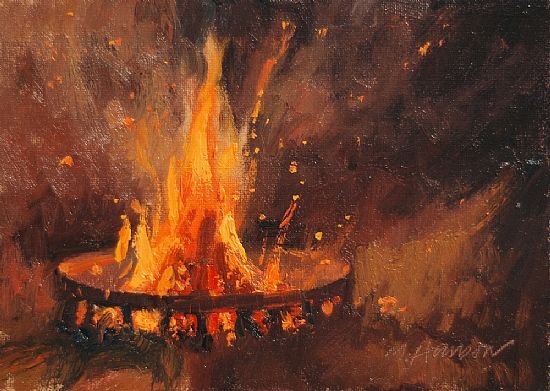WHAT IF? (Part 3b: Beyond helplessness)
 September 8, 2019
September 8, 2019  © Marc Hanson Used by permission of artist.
© Marc Hanson Used by permission of artist.
The last post helped me to calm down—but I still didn't know what to do about the hazelnut sprayers.
What I could see was that my first response was violence—violence toward the workers in wanting to scream at them to stop; violence toward myself in telling myself there was nothing I could do. Either leads to helplessness: I’m either helpless to the strength of my emotion, or helpless to my inner criticism.
I am looking for a third option.
What I find is something I will call containment. There will always be affliction. Life lives on other life. There is no getting away from it. It doesn’t matter where on the food chain we eat, we are eating living beings, plants included.
In this case, there will always be affliction associated with growing food—hard work, weather, insects, markets. A farmer is faced with all kinds of difficulties. This farmer’s attempt to deal with these difficulties is pretty normal. (Though what the normal response seems to miss is that this style of farming attempts to destroy the afflictions themselves without seeming to recognize the whole new set of afflictions this creates.)
Similarly, my response to the people spraying is normal—my anger, fear, and disgust are all natural responses to feeling threatened. These are not only normal, but these responses are necessary—they let me know that I am alive and awake. They let me know what I care about.
The question isn’t how do I get rid of all affliction, or how do I get rid of my responses—these are both impossible. The question is, how do I contain my response, like a fire in a hearth, so that it provides useful heat, rather than a destructive blaze?
In this case, I can think of several options:
First, by pausing. Just stopping before acting allows my mind to settle so that I can think clearly.
Second, by my attitude toward my response. A friendly attitude to all of my feelings allows calmness to arise more readily. A critical, self-blaming attitude only creates more upset emotions.
Third, is to really feel what I feel. To name my feelings—all of them—and to simply experience them, viscerally, just as they are.
When I do these things, finally my mind begins to open up and start to work again, and I think of some alternatives to the violence of my first impulse.
- I can talk to the workers to find out what they are spraying.
- I can ask the landowner to give us notice if they are spraying in the future.
- I can research hazelnut farming practices.
- I can choose to purchase organic hazelnuts.
- I can invest in an organization that promotes organic farming in the Willamette Valley.
Or, the option that I had already instinctively taken:
- I can write a blog post about it.
This whole approach of containment is not something I thought up myself. It is another example of help, in this case in the form of a book that I had read before, but forgotten, until I unearthed it from a storage box just after the spraying incident. The book is David Brazier’s The Feeling Buddha, which offers a practical approach to acting with courage in the face of life’s inevitable challenges. This is based on Brazier’s interpretation of the Buddha’s first teaching, but does not require Buddhist beliefs to appreciate or practice.
Brazier’s book helped me see that part of my helplessness came from my misconception that my action had to eliminate the affliction. I was trapped in an all-or-nothing approach. If I can’t “solve the problem”, then why bother trying at all? Since most problems are not solvable, this results in a lot of “why bothering.”
Not only that, but it was okay that the problem wasn’t solvable—this is the nature of most problems. Even if a problem has a solution, there is another problem waiting to take its place. This is part of the natural order of life—that problems, afflictions, exist. Birth to death we are faced with them. And that’s okay. Just because we face problems doesn’t mean we are failures. It just means we are alive.
I will let you read the book yourself if you are interested in more about this. But I would like to return briefly to the statement I made last post that we need all the shadow parts of ourselves. Whatever for? Wouldn’t we all be better off without them?
All these things that rise up in us let us know what actually lives in the depths of our minds. It lets us know what we fear, what we hate, what we don’t understand, what we crave. All of this is important information. It lets us know with exquisite accuracy what work we have to do.
But the work we have to do is not the work of eradication. It is the work of containment—again, containing the fire in the hearth. Afflictions are the fuel; our responses are the spark. Fuel and spark together creates the fire that we can then use—when protected from the wind—to nourish passionate, meaningful lives.
We need the shadow parts not only because they represent dismissed aspects of our multifaceted selves, but simply because they contain a lot of energy. When I cut the parts I don’t like out of my life, I reduce myself—my fire is too little. When I allow these parts to rule me, my fire gets too hot—I destroy myself.
We are invited instead to a practice of constant tending. To see the affliction of our lives for what it is: beyond good and bad, failure and success, it is fuel for the fire of a meaningful life.
---------------
Brazier, David. (2002). The Feeling Buddha: A Buddhist Psychology of Character, Adversity and Passion. New York: Palgrave